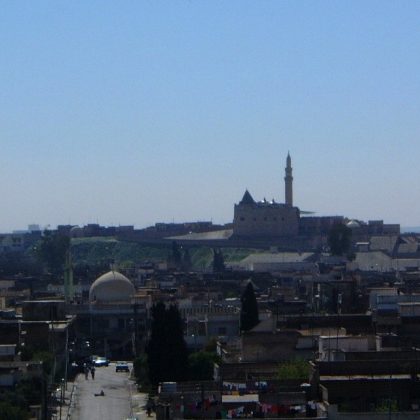The ancient history and heritage of the Mosul region: an A–Z, Part II
July 2017 marked the official liberation of the northern Iraqi city of Mosul, after more than three years of horrifying occupation by ISIS/Da’esh. At the time of writing, there are still isolated areas of fighting in the war-battered medieval Old City on the west bank of the Tigris, and many hundreds of thousands of traumatised, injured people are mourning the loss of their homes and their loved ones in the IDP camps around the city.
Yet our indefatigable colleagues of the Nineveh Governorate’s antiquities and heritage department are already assessing the city’s heritage buildings and archaeological sites for looting, damage, structural safety, and beginning to compile the documentation needed for long-term management plans. The immediate aim is to ensure the security and stability of vulnerable places while the city’s pressing humanitarian needs are taken care of. The British Institute for the Study of Iraq and other organisations are working with them in this endeavour, offering as much support as we can.
In due course, the time will come to make informed decisions about the future of the Mosul region’s built infrastructure, old and new. In the mean time, to help deepen our collective knowledge of its extraordinary longevity and variety, here is a second selection of articles from Iraq about Mosul’s ancient and medieval history, and some of the key people involved in discovering it.
Judaism
The ancient city of Nineveh famously features in the Old Testament as the destination of the reluctant prophet Jonah, sent to preach against Assyrian idolatry. Indeed, tradition has it that Jonah was buried on the high mound of east Mosul now called Nebi Yunus, “Prophet Jonah”. In this paper, Baruch Levine argues that Jewish belief in a single god was crystallised partly in reaction to the polytheism of Assyria, the Middle East’s most dominant imperial force in the early first millennium BC.
- Baruch A. Levine, “Assyrian ideology and Israelite monotheism”, Iraq 67 (2005): 411–427.
Kalhu (Nimrud)
Some 30 km to the south of Mosul lies Nimrud, ancient Kalhu, Assyria’s most important royal city in the 9th and 8th centuries BC. In this article David Kertai discusses two of its palaces, which fundamentally influenced Assyrian royal architecture in later times. One of them, the Northwest Palace, was badly damaged by ISIS/Da’esh for a propaganda video in 2015. The other, Fort Shalmaneser, remains untouched. The site is now protected by guards and a new security fence.
- David Kertai, “Kalhu’s palaces of war and peace: Palace architecture at Nimrud in the ninth century BC”, Iraq 73 (2011): 71–85.
Layard, Austen Henry (1817–1894)
Layard is often credited as a pioneer archaeologist, the man who rediscovered Biblical Nineveh for the British Museum in the 1840s and 50s. But we should be careful with those terms. He was certainly an intrepid explorer and effective self-publicist but he was not the first westerner to explore the antiquarian remains of Mosul — John Claudius Rich and Paul-Émil Botta both came before him. Nor was he, in modern terms, an archaeologist, decades before that profession came into being. But his voluminous documentation helps to compensate for the necessarily experimental and haphazard nature of his excavations, as John Russell shows.
- John Malcolm Russell, “Layard’s description of rooms in the Southwest Palace at Nineveh”, Iraq 57 (1995): 71–85.
Mosul to Nisibin
In pre-modern times, long journeys were typically described as itineraries from place to place, rather than drawn on a two-dimensional map. The ancient city of Nisibin or Nisibis, modern Nusaybin on the Turkish-Iraqi border, lies 200 km to the northwest of Mosul. Its history is almost as long and complex as that of Mosul, and there was always a great deal of communication between them. Here J.M. Fiey reads the Arab geographers’ accounts of their journeys to map the route used a thousand years ago, during the Abbasid empire.
- J.M. Fiey, “The Iraqi section of the Abbasid road Mosul—Nisibin”, Iraq 26 (1964): 106–117.
Nineveh in the 4th century CE
Although Nineveh in east Mosul is most famous as the Assyrian royal city of the 7th century BC, its history stretches for millennia either side of that heyday. Here St John Simpson surveys the evidence for Christian Nineveh, a thousand years after the fall of the Assyrian empire.
- St John Simpson, “Christians at Nineveh in late antiquity”, Iraq 67 (2005): 285–294.
Oates, David (1927–2004) and Joan Oates (1928–present)
Joan Oates and David Oates made an extraordinary wide range of contributions to the archaeology of northern Iraq. They are perhaps best known for their work on prehistory as well as on Neo-Assyrian Kalhu/Nimrud. But here I have chosen an early collaboration of theirs that deserves to be much better known: the excavation of a Roman barracks just south of the Jebel Sinjar mountain to the west of Mosul.
- David Oates and Joan Oates, “Ain Sinu: a Roman frontier post in northern Iraq”, Iraq 21 (1959), 207–242.
Prehistory
Pottery is one of the most important means of dating prehistoric sites. Styles are typically named after the archaeological site (and level) in which they were first found. “Ninevite 5” was identified by Max Mallowan at Nineveh in 1929 — in the presence of his future wife, Agatha Christie. In this paper, light-heartedly named after one of Christie’s most famous detective novels, Michael Roaf and Robert Killick sleuth their way through nearly sixty years of archaeological work to propose a dating in the early third millennium BC for this important northern Iraqi ware.
- Michael Roaf and Robert Killick, “A mysterious affair of styles: the Ninevite 5 pottery of northern Mesopotamia”, Iraq 49 (1987): 199–230.
Queens
In 1988–90, Iraqi archeologist Muzahim Mahmoud Hussein famously discovered a sequence of tombs under the domestic quarters of the Northwest Palace in Nimrud. They contained the skeletons of several Assyrian queens of the ninth and eighth centuries BC, along with vast quantities of gold jewellery and other precious goods. Here Dominique Collon examines the imagery on three pairs of the queens’ bracelets, focusing especially on a “wrongly” made image of the Assyrian winged disk. What could it mean?
- Dominique Collon, “Getting it wrong in Assyria: some bracelets from Nimrud”, Iraq 72 (2010): 149–162.
Rassam, Hormuzd (1826–1910)
Rassam was a well-connected Chaldean Christian from Mosul, hired by Layard to work with him at Nimrud in 1845. As Julian Reade shows here, Layard’s patronage led to a long career excavating Iraqi antiquities for the British Museum, interspersed with some dangerous diplomatic postings across the British Empire. A particularly unpleasant dispute with a senior British Museum colleague led to a successful court case but an unhappy end to Rassam’s career.
- Julian Reade, “Hormuzd Rassam and his discoveries”, Iraq 55 (1992): 39–62.






